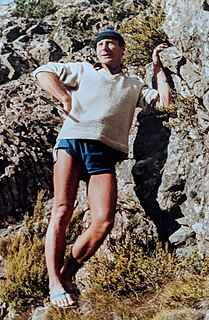Botany is the scientific study of plant life.
Contents
Botany may also refer to:
Botany is the scientific study of plant life.
Botany may also refer to:

Daniel Carlsson Solander or Daniel Charles Solander was a Swedish naturalist and an apostle of Carl Linnaeus. Solander was the first university-educated scientist to set foot on Australian soil.

Leonard Cockayne is regarded as New Zealand's greatest botanist and a founder of modern science in New Zealand.
John Carne Bidwill was an English botanist who documented plant life in New Zealand and Australia. He is attributed with the discovery of several Australian plant species.

Thomas Frederick Cheeseman was a New Zealand botanist. He was also a naturalist who had wide-ranging interests, such that he even described a few species of sea slugs.

Lucy May Cranwell FRSNZ was a New Zealand botanist responsible for groundbreaking work in palynology. Cranwell was appointed curator of botany at Auckland Museum in 1929, when she was 21 years old. As well as her work on ancient pollen samples she was responsible for encouraging a love of botany in a generation of Auckland children.
Eric John Godley OBE, FRSNZ, Hon FLS, Hon DSc (Cantuar.), AHRNZIH was a New Zealand botanist and academic biographer. He is best known for his long-running series of in the popular magazine New Zealand Gardener and his "Biographical notes" series that ran in the New Zealand Botanical Society Newsletter and which is the prime resource on the lives of many New Zealand botanists.

Thomas Kirk was an English-born botanist, teacher, public servant, writer and churchman who moved to New Zealand with his wife and four children in late 1862. The New Zealand government commissioned him in 1884 to compile a report on the indigenous forests of the country and appointed him as chief conservator of forests the following year. He published 130 papers in botany and plants including The Durability of New Zealand Timbers, The Forest Flora of New Zealand and Students' Flora of New Zealand.

Lucy Beatrice Moore was a New Zealand botanist and ecologist.
Ruth Mason was a New Zealand botanist specialising in the taxonomy and ecology of freshwater plants.
John Ernest Holloway, FRS was a New Zealand Anglican priest, botanist and university lecturer.

Harry Howard Barton Allan was a New Zealand teacher, botanist, scientific administrator, and writer. Despite never receiving a formal education in botany, he became an eminent scientist, publishing over 100 scientific papers, three introductory handbooks on New Zealand plants, and completing the first volume of a flora in his lifetime.
Una Vivienne Cassie Cooper is a New Zealand planktologist and botanist.
Peter Wardle was a New Zealand botanist.

Roderick Leon Bieleski was a New Zealand plant physiologist. As a botanist and horticulturist, his research focussed on understanding the factors that affected the behaviour of plants, in particular horticultural crops. His work had practical relevance to farmers and orchardists in building their understanding of these factors and taking account of them while making a living from growing and harvesting plants. He received many honours and awards, culminating in being appointed Member of the New Zealand Order of Merit (MNZM) in 2010.

The Flora Antarctica, or formally and correctly The Botany of the Antarctic Voyage of H.M. Discovery Ships Erebus and Terror in the years 1839–1843, under the Command of Captain Sir James Clark Ross, is a description of the many plants discovered on the Ross expedition, which visited islands off the coast of the Antarctic continent, with a summary of the expedition itself, written by the British botanist Joseph Dalton Hooker and published in parts between 1844 and 1859 by Reeve Brothers in London. Hooker sailed on HMS Erebus as assistant surgeon.
Peter James de Lange is a New Zealand botanist.
Grace Marie Taylor née Bulmer was a New Zealand mycologist and botanist as well as a scientific illustrator. She described several new species of fungi and published and illustrated books on New Zealand fungi and plants.
Marguerite Winifred Crookes was a botanist and conservationist from New Zealand and founder of the Auckland Natural History Club. Her best known work is Plant Life in Maoriland: A Botanist’s Note Book.

John Kenneth Bartlett was a New Zealand plant collector and botanist who specialised in mosses, liverworts, and lichens. In 1974, he found Bartlett's rātā growing south-east of Cape Reinga.

Veronica jovellanoides, commonly known as Riverhead speedwell, is a threatened flowering plant in the family Plantaginaceae. Endemic to New Zealand, only three plants are known in the wild. All are found within the Ernest Morgan Reserve, a 20 ha forest northwest of Auckland. Its discovery is accredited to a retired plant nursery owner, Geoff Davidson, who organised the land's protection a few decades prior, and found it by chance on a walk in November 2007.